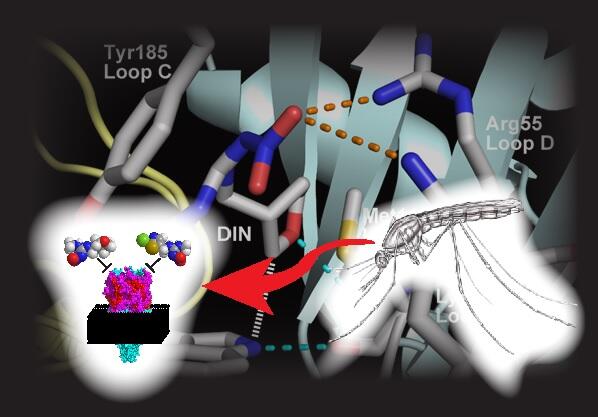A research group led by Professor Kazuhiko Matsuda of the Department of Applied Biological Chemistry, Graduate School of Agriculture at Kindai University, in collaboration with the Institute of Scientific and Industrial Research at Osaka University, the Faculty of Pharmaceutical Sciences at Okayama University, University College London in the United Kingdom, and the Liverpool School of Tropical Medicine, has announced that they have analyzed the mechanism of action of neonicotinoid insecticides against the malaria vector Anopheles gambiae. They also successfully estimated the mechanism by which neonicotinoid insecticides inhibit the flight ability of A. gambiae. These findings are expected to contribute to the development of effective insecticides for insect control and to the reduction of not only malaria but also dengue fever. The results were published in the international journal Open Biology on July 24.

Provided by Kindai University
Malaria is an infectious disease that is prevalent mainly in Africa. It is transmitted by Plasmodium parasites that are injected into the human body by mosquitoes that feed on blood. Malaria infects more than 200 million people and kills approximately 600,000 people annually.
A measure to combat malaria is to kill the mosquitoes that carry the Plasmodium parasite. However, the number of infected individuals is increasing because an increasing number of A. gambiae have acquired resistance to insecticides used worldwide, such as synthetic pyrethroid insecticides. Therefore, the use of neonicotinoid insecticides with different mechanisms of action is being considered. Neonicotinoid insecticides affect the behavior of insects by inhibiting the function of nicotinic acetylcholine receptors in the central nervous system, exerting insecticidal effects. Meanwhile, there are many subtypes of the nicotinic acetylcholine receptor due to which the interaction and mechanism of action with these receptor subtypes were not known in detail.
Previously, the research group developed a technology for ectopic expression of nicotinic acetylcholine receptors in 2020. In this study, they used this technology to analyze the mechanism of action of six neonicotinoid insecticides (imidacloprid, thiacloprid, clothianidin, acetamiprid, dinotefuran, and nitenpyram) on 13 nicotinic acetylcholine receptor subtypes that are important for neurotransmission in A. gambiae. The results showed that the efficacies of the six insecticides differed for each receptor subtype. Among them, the receptor binding mechanism of dinotefuran was clarified based on its crystal structure.
Neonicotinoid insecticides exhibit knockdown activity against adult females of A. gambiae, inhibiting their ability to fly. In this study, the research group succeeded in identifying the nicotinic acetylcholine receptor subtypes that were particularly strongly affected in association with this effect. Similar effects are expected to be noted in males. Neonicotinoid insecticide effects on the dengue fever vector Aedes aegypti are also considered to be exerted through a similar mechanism.
Matsuda said, "Neonicotinoids are often explained simply by saying that they act on nicotinic acetylcholine receptors, but it was not at all clear which of so many subtypes of this receptor contribute to the occurrence of insect toxicity. In this study, we attempted to address this issue in the malaria vector A. gambiae and found that specific nicotinic acetylcholine receptor subtypes play particularly important roles in toxicity. A lot of effort was required to solve this, but I was amazed how brilliantly we did it."
Journal Information
Publication: Open Biology
Title: Unravelling nicotinic receptor and ligand features underlying neonicotinoid knockdown actions on the malaria vector mosquito Anopheles gambiae
DOI: 10.1098/rsob.240057
This article has been translated by JST with permission from The Science News Ltd. (https://sci-news.co.jp/). Unauthorized reproduction of the article and photographs is prohibited.




